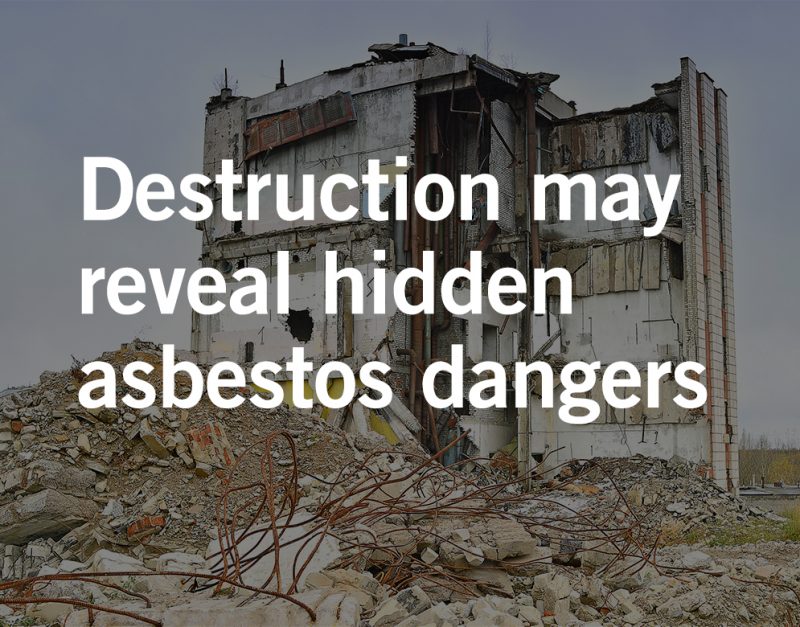 November 26, 2018
November 26, 2018 Environmental disasters can potentially expose first responders and the public to asbestos, putting them at risk for mesothelioma.
The possibility of asbestos exposure after environmental disasters continues to be an issue in the U.S. From natural disasters like Hurricane Katrina and Superstorm Sandy to the tragic events of 9/11, there is much to be learned about how to handle toxic substances such as asbestos after a disaster.
What is Asbestos?
Asbestos is a microscopic and carcinogenic fiber that was commonly used in building materials through the 1970s. If those older buildings (many of them homes) are still in existence, so is the asbestos that is in them. When asbestos-containing materials are disturbed, toxic dust may be inhaled, forming deposits in the lungs that can cause serious and deadly illnesses.
Because the latency period for mesothelioma is 30 to 50 years, and symptoms are not seen immediately, it is critical for emergency managers to recognize health concerns and ensure that the removal of asbestos is handled by specially trained professionals who are certified in abatement, follow regulations, and use the proper gear.
But what happens when situations are time-sensitive, and first responders have to act immediately, putting themselves at risk for potential exposure? When dealing with older structures containing asbestos, EMTs, paramedics, firefighters, law enforcement, demolition crews, and anyone else nearby are at significant risk of developing an asbestos-related illness years later as any form of building damage may result in toxic debris and airborne asbestos spreading for miles.
There are preventative measures that can be taken to limit asbestos exposure.
- Install air quality monitors to produce real-time data of asbestos levels.
- Enforce asbestos inspections prior to demolition.
- Provide grant assistance for asbestos removal.
Safe handling practices must be enforced to protect first responders and families in hard-hit areas from surging cancer rates in decades to come. Officials must look at the average age of homes in a city impacted by a natural or environmental disaster and make the best decisions based on that situation.
If you suspect that your home, school, or office building may contain asbestos materials:
- Follow established EPA and OSHA guidelines and regulations.
- Hire a professional for testing, abatement, and/or disposal.
- Do not disturb, create, or breathe the dust.
- Use OSHA-approved respiratory protection if you must handle asbestos debris.
How Can Waters Kraus Paul & Siegel Help Victims of Asbestos Exposure?
Waters Kraus Paul & Siegel has been representing asbestos victims for decades. The asbestos attorneys of this mid-sized plaintiffs’ firm aggressively fight to hold negligent corporations responsible for their use of asbestos, which has been known since the 1930s to cause deadly diseases such as mesothelioma. Email or call 800.226.9880 to discuss your potential lawsuit with the experienced asbestos attorneys of Waters Kraus Paul & Siegel.


